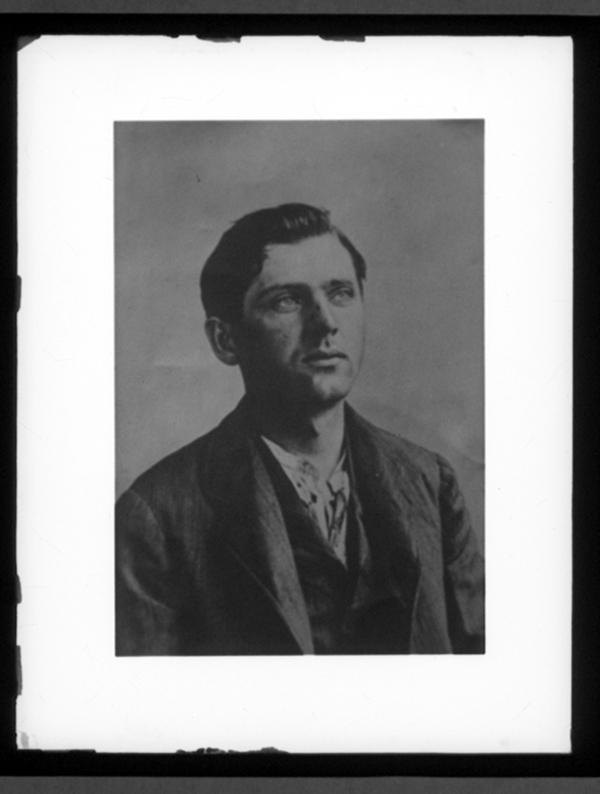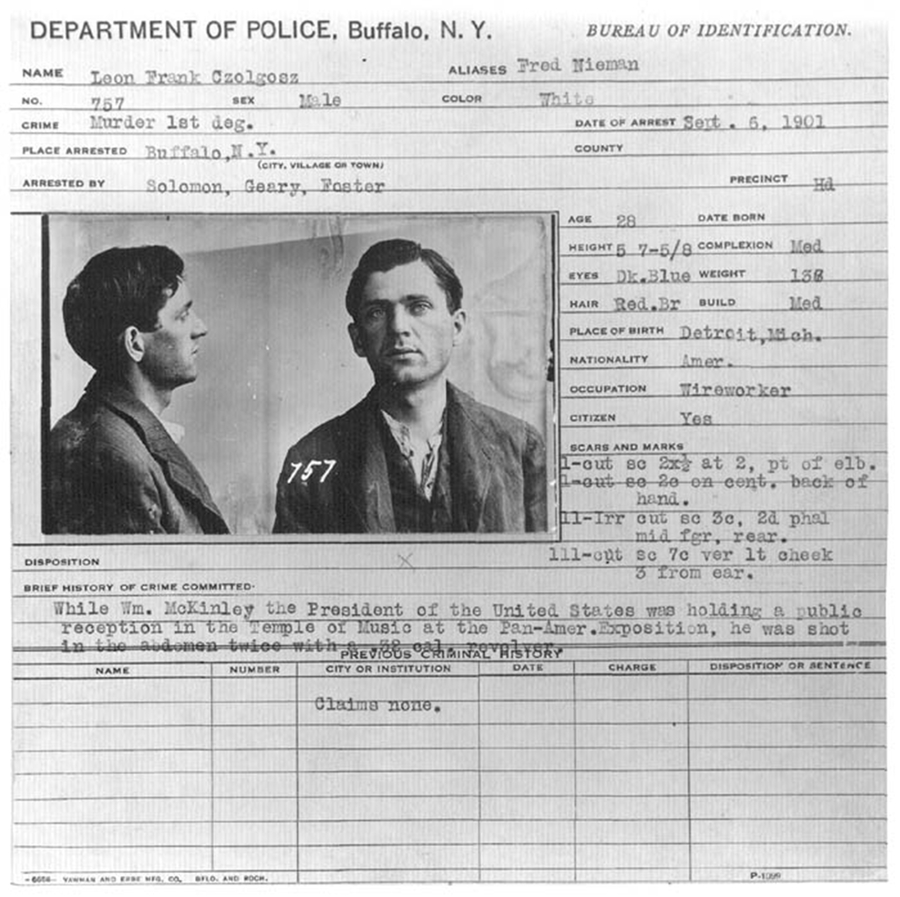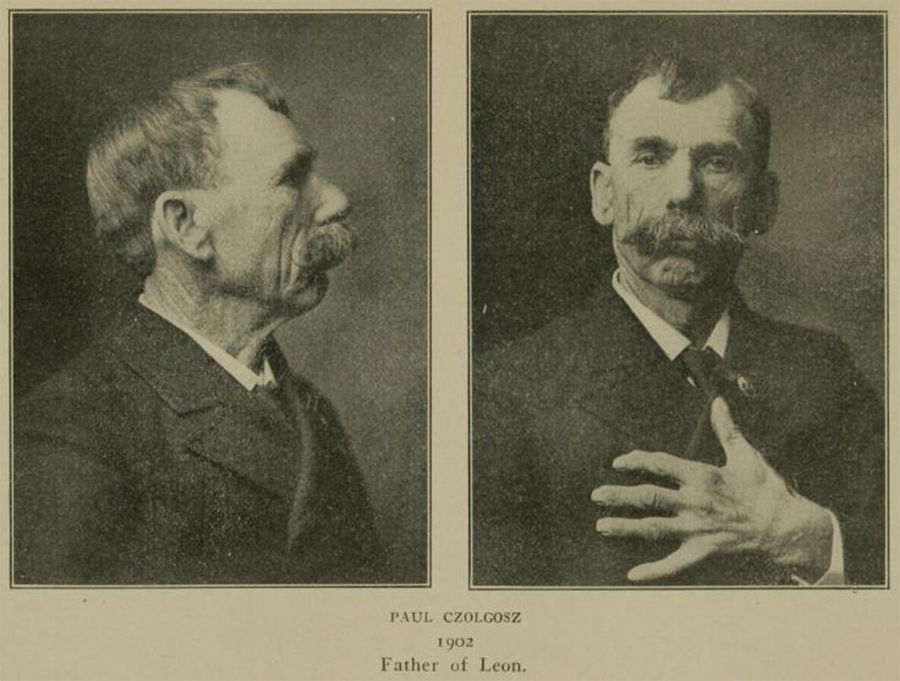William Vander Weyde’s portrait of Leon Czolgosz—mill-worker, son of Polish immigrants, and assassin of President William McKinley—is undated. But we know it was taken sometime after Czolgosz fired two shots into the President’s abdomen on September 6, 1901, as he greeted the public on the steps of Buffalo’s Temple of Music during the Pan-American Exposition.1 And we know it was taken sometime before Czolgosz was put to death in the electric chair at Auburn State Prison on October 29, 1901, having refused priestly ministrations. “I don’t want them and I don’t want them praying over me when I’m dead. I don’t want any of their damned religion.”2 Disheartened by the Gilded Age’s vast disparities of fortune, marginalized by the Protestant discourse of American progress, and inspired by the revolutionary tenor of anarchist dissent, Czolgosz noted that he shot the President “for the sake of the common people.”3 He was sentenced to death following a rapid pace trial; the jury took just twenty-five minutes to return their verdict.
After Czolgosz shot McKinley, William Vander Weyde shot Czolgosz. Vander Weyde was what the turn-of-the-century identified as a new species of “news-photographer,” with most of his images commissioned to illustrate investigative reporting in newspapers and weekly magazines. As Broadway magazine noted in an 1898 profile of Vander Weyde, “one can scarcely pick up two consecutive copies of progressive newspapers like the World and Journal, The Illustrated American, Harper’s Weekly or Munsey’s without seeing on one or more of the most absorbing pictures the legend, ‘Copyright by Vander Weyde.’ These words are never found on a ‘slow’ picture.”4 Employing faster film and shutter speeds than his nineteenth-century predecessors, Vander Weyde produced images that were clear-eyed, “quick,” and ubiquitous.5
Vander Weyde’s portrait of Czolgosz yokes the development of visual technologies to the pace of modern punishment; it is at once a bringing to light and a bringing to death. Perched between the turn-of-the-century’s apotheosis of speed and an arresting stillness, the image resists any effort to narrate technological development—and particularly the co-emergence of photographic and electric technologies—through an uncomplicated account of the secular. Early debates around the use of the electric chair pivoted, for example, on the convergence of state and divine power. In the winter of 1887, as New York’s state legislature debated introducing the electric chair for capital punishment, novelist and editor William Dean Howells wrote to Harper’s Weekly with a wry protest:
One journal has drawn an interesting picture of the simple process, and I have fancied the executions throughout the State taking place from the Governor’s office, where his private secretary, or the Governor himself, might touch a little annunciation-button, and dismiss a murderer to the presence of his Maker with the lightest pressure of the finger.6
Linking lethal electrocution to public taste for spectacular feats of long-distance electrification, Howells decried the abstraction of death enabled by the chair, its status as entertainment in an increasingly electrified American infrastructure. Through the idiom of touching a button, Howells cited and reconfigured the nineteenth century’s technological enthusiasm—its quasi-religious worship of electricity’s spiritual and material potential—to register the limits of electric technologies for Progressive thought.7
By the turn of the century—the moment of Czolgosz’s execution—electrocution had become America’s preferred method of capital punishment. Politicians and reformers celebrated electrocution as a critical improvement in executions, a boon to modern death that paralleled and reinforced the boon that push-button technologies had offered to modern life.8 Yet the avowed hope of the chair’s proponents—that electrocution would be quicker, cleaner, and less painful than hanging—was repeatedly shown to be a false one. By 1904, Howells would offer an even more strident critique of electrocution, or what he described as state-inflicted manslaughter. Responding to the perhaps inevitable failure of the electric chair to kill without killing, Howells wrote of the failure of vision that plagued the chair’s early advocates:
They could not foresee that the mystical element whose agency they had invoked […] could bungle its sacred mission. The culprit would be carefully seated, somewhat as the subject of photography is, and assuming as cheerful or as submissive an expression as possible, would be thrilled into the other world with the touch of a button, or the turn of a key, by the hand of a scientific gentleman, or at least an educated electrician, on the other side of a wall or screen.9
Like Howells’s essay, Vander Weyde’s image registers an unsettling proximity between the disciplinary function of the electric chair and the aesthetic function of the photograph. As Howells suggests, if to be electrocuted is to be thrilled by the touch of a button, then electrocution’s attractiveness as a method of capital punishment might echo and redouble the popularity of the hand camera, which, as Alfred Stieglitz observed in 1897, offered photography to the masses as entertainment, or “no work and lots of fun.” As Stieglitz put it, Kodak’s marketing slogan “You press the button, we do the rest” worked to “enlarg[e]” “the ranks of enthusiastic Button Pressers” to potentially “enormous dimensions.”10 Invented in 1888, two years before the first electric chair was installed in New York’s Auburn State Prison, Kodak’s hand camera made button-pressing available to the masses. Thus Howells links the cultural shock of electrocution to the work of art in the age of mechanical reproduction: thrilling but also potentially numbing or deadening, and available to almost anyone.
Superimposing the death chamber and the photographic studio, Vander Weyde’s image makes visible the reifying force of electrocution: its transformation into cheerful routine, its consolidation of “sacred” event and streamlined manufacture. Newly linked to the temporality of the news and the rhythms of mass communication, the image points to the turn of the century’s specific conjunction of aesthetic, disciplinary, and material fascination with immediacy.11 The glorification of speed was at once cultural and physiological; juxtaposing electricity’s movement to the comparatively slower work of the nervous system, for example, early experiments in electrocution aimed to prove that an electric current would travel through the body faster than nerve signals, making the process entirely painless.12 Similarly, the instantaneity of shock and image increasingly paralleled the speed of modern information. As Tim Armstrong points out, the proliferation of media reports surrounding early electrocutions meant that death itself looked increasingly like a function of technological reproduction, an event of one’s fingertips.13
Somewhere between an annunciation and a mug shot (see Fig. 2), Vander Weyde’s portrait of Czolgosz squares the difference between witnessing and button-pressing, the Word made flesh and the disincarnating work of modern technology.14 As Howells intimated, touching a button made possible the mass reproducibility of corpses as both objects and images; both in and before death, Czolgosz was a product of this system (in an image from January 1902, Paul Czolgosz—Leon’s father—wears a button on his lapel bearing his son’s image).15 In the haptic logic of touching a button, Vander Weyde’s image fingers Leon Czolgosz as criminal under the sign of political, ethnic, and religious difference. In the lead up to the execution, it marks his becoming-object in advance.16 Yet it also does more than this. With a haunting stillness, the photograph unsettles the logic of speed and instantaneity that underwrote industrial modernity. Its temporality is recursive, not linear. If it does not or cannot preserve life, it nevertheless returns us to the very moment the button was pressed, and asks us to hold that moment distinctly in reserve.
Notes
Notes
1. On events surrounding the assassination of President McKinley, see Eric Rauchway, Murdering McKinley: The Making of Theodore Roosevelt’s America (New York: Hill and Wang, 2004) and Scott Miller, The President and the Assassin: McKinley, Terror, and Empire at the Dawn of the American Century (New York: Random House, 2011).
2. Miller, The President and the Assassin, 329.
3. Rauchway, Murdering McKinley, 53.
4. Chauncy Montgomery McGovern, “Vander Weyde’s 'News-Photography,'” Broadway Magazine 2, no. 9 (December 1898): 682.
5. Catalog note courtesy of George Eastman House.
6. William Dean Howells, “Execution by Electricity,” Harper’s Weekly 32 (January 1888): 23.
7. On the links between the electric chair and discourses of the sublime, see Jürgen Martshukat, “‘The Art of Killing by Electricity’: The Sublime and the Electric Chair,” The Journal of American History 89, no. 3 (December 2002): 900-921. doi:10.2307/3092345
8. On the rise of push-button technologies, see Rachel Plotnick, “At the Interface: The Case of the Electric Push Button, 1880-1923,” Technology and Culture 53, no. 4 (October 2012): 815-845. doi:10.1353/tech.2012.0138
9. William Dean Howells, “State Manslaughter,” Harper’s Weekly 48 (February 1904): 196-198. Cited in Phillip English Mackey, ed., Voices Against Death: American Opposition to Capital Punishment, 1787-1975 (New York: Burt Franklin & Co, 1976), 151.
10. Alfred Stieglitz, “The Hand Camera—Its Present Importance,” American Annual of Photography and Photographic Times Almanac (New York: The Scovill & Adams Company, 1897), 18-27. Cited in Vicki Goldberg, ed., Photography in Print (Albuquerque: University of New Mexico Press, 1988), 215.
11. As Mark Seltzer notes, turn-of-the-century push buttons figured a form of “violent immediacy,” forging “an identity between signal and act and an identity between communication and execution—‘execution’ in its several senses.” Mark Seltzer, Bodies and Machines (New York: Routledge, 1992), 11.
12. See Mark Essig, Edison and the Electric Chair: A Story of Light and Death (New York: Walker & Company, 2005), 45-48.
13. Tim Armstrong, Modernism, Technology and the Body: A Cultural Study (New York: Cambridge University Press, 1998), 31-36.
14. While not an official mug shot, Vander Weyde’s portrait appears to have been taken in close proximity to one; note the resemblance to the above image (Fig. 2) from the police report, in which Czolgosz wears the same clothing.
15. In his 1921 study The Manner of the Man That Kills, L. Vernon Briggs describes the making of this image during a 1902 visit to the Czolgosz family in a Polish enclave of Cleveland, Ohio: “I persuaded Paul Czolgosz to accompany me to have his picture taken by Charles Horton and Co., 121 Euclid Avenue. He dressed for the occasion in his best clothes with a small button-picture of Leon pinned through a black ribbon on the lapel of his coat.” Briggs, The Manner of the Man That Kills (Boston: R. G. Badger, 1921), 291-292. See also Rauschway, Murdering McKinley, 118.
16. Avery Gordon has argued similarly of Edwin S. Porter’s 1901 filmic reenactment: “A perception of the subjectivity of the so-called object is exactly what Execution of Czolgosz does not animate or conjure.” Avery F. Gordon, “Execution of Czolgosz, with Panorama of Auburn Prison (1901),” Animism, vol. 1, ed. Anselm Franke (Berlin: Sternberg Press, 2010), 80.
Keywords
Imprint
10.22332/con.obj.2014.51
1. Lindsay Reckson, "William Vander Weyde, Leon F. Czolgosz, McKinley Assassin," Object Narrative, in Conversations: An Online Journal of the Center for the Study of Material and Visual Cultures of Religion (2014), doi:10.22332/con.obj.2014.51
Reckson, Lindsay. "William Vander Weyde, Leon F. Czolgosz, McKinley Assassin." Object Narrative. In Conversations: An Online Journal of the Center for the Study of Material and Visual Cultures of Religion (2014). doi:10.22332/con.obj.2014.51





